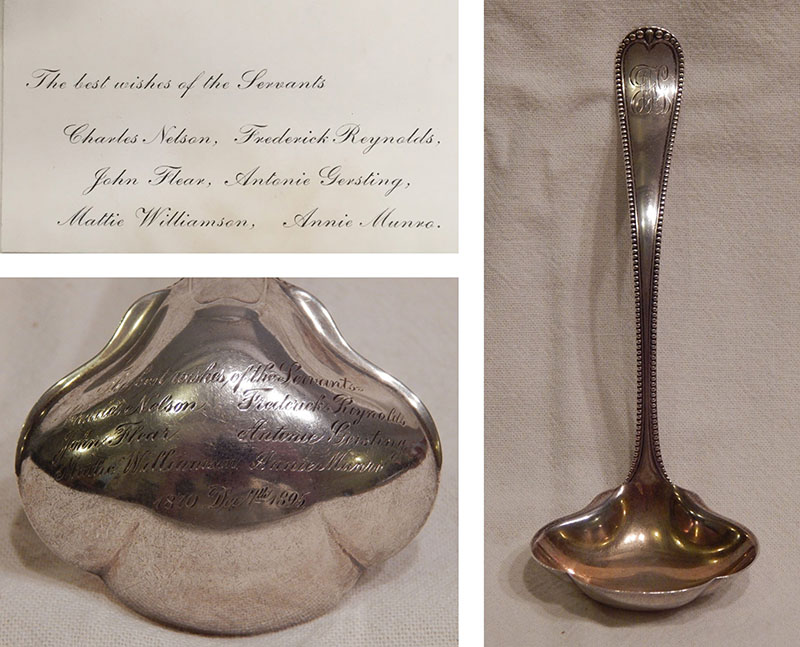Sauce Ladle

| Maker | Gorham |
| Date of Creation | 1895 |
| Location | Providence, RI |
| Materials | Sterling silver |
| Institution | Glessner House |
| Credit Line | Charles F. Batchelder III |
| Accession Number |
G95.2.95 |
| Photo Credit | Glessner House |
On December 7, 1895, John and Frances Glessner celebrated their 25th wedding anniversary. Frances Glessner recalled in her journal that the butler “Frederick came and in a very graceful way asked me to accept two beautiful gravy ladles from the servants. With the spoons came a card ‘with the best wishes of the servants’ followed by their names arranged according to the length of time they have been with us. These gifts were all in the most perfect taste and touched us deeply. After dinner, John called them in and thanked them for us both.”
The ladle, in the Newcastle pattern, features a long curving handle with the JFG monogram at top and delicate beading along the edge on both the front and back. The deep, scalloped bowl is gilt on the inside. What is most special about the piece, however, is the back of the bowl. Frances Glessner was so touched by the gift that she brought it to Spaulding & Co. and had the message from the card engraved on the back:
“The best wishes of the servants
Charles Nelson Frederick Reynolds
John Flear Antonie Gersting
Mattie Williamson Annie Munro”
To this, at the bottom, she added “1870 Dec 7th 1895” noting the dates of her wedding and her 25th anniversary.
Charles Nelson was the coachman and had been with the family since 1878. Frederick Reynolds joined the staff as butler in 1891. John Flear had served as footman for three years; in 1923 he returned as butler. Antonie Gersting was the ladies maid, Mattie Williamson was the cook, and Annie Munro was a maid; all had been with the family just a few years. Mattie would become one of the longest serving members of the household, remaining for 20 years until her marriage in 1912. All of these servants were immigrants: Frederick Reynolds and John Flear were from England, Charles Nelson was from Sweden, Mattie Williamson was from Canada, Antonie Gersting was from France, and Annie Munro was from Scotland.
Frances Glessner’s thoughtful addition of the sentiment from the card to the back of the ladle ensured that the story of its presentation to the Glessners on their anniversary would always be preserved. It also reflects the somewhat unexpectedly close relationship between family and staff, likely rooted in the Glessners’ early years. Both came from middle-class families in central Ohio; the couple met when John Glessner rented a room from his future wife’s family, the Macbeths. Prior to their 1870 marriage, Frances helped her mother manage the household, giving her an understanding of the hard work involved in maintaining a home. During construction of their Prairie Avenue house, she worked closely with Richardson in the design of the servants’ living quarters, ensuring each had a private room, abundant light, and closets, in spaces finished off with quartersawn oak—the same material used in the formal family rooms.
Entries in Frances Glessner’s journals document long relationships with staff, often extending well after they retired. John Glessner would invest their earnings in public utility stocks to ensure they had a nest egg for their later years. In several instances, the Glessners set up boarding house arrangements for staff no longer able to execute their duties, ensuring they would have good meals and a comfortable place to live. Correspondence with Mattie Williamson, one of those who presented the ladle, continued after she married and moved to California, the Glessners’ daughter later traveling to visit her when she was diagnosed with a serious heart ailment.
The sauce ladle is a tangible reminder of the carefully structured lives of the upper-classes in Chicago and elsewhere in the late nineteenth century, and how some families, like the Glessners, crossed the boundaries of class to form lasting bonds with those who worked for them.
